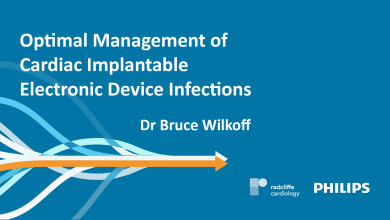Search results
Author(s):
Rikke Esberg Kirkfeldt
,
Jens Brock Johansen
,
Jens Cosedis Nielsen
Added:
3 years ago
Cardiac implantable electronic device (CIED) therapy is effective and safe. However, infections related to CIED treatment may have devastating consequences, causing significant morbidity, mortality and generating considerable healthcare costs.1–6 Temporal trends in CIED treatment indicate a disproportional increase in CIED infections relative to implantation rates.1,7,8 Reasons for this trend are…
View more
Author(s):
Niek EG Beurskens
,
Fleur VY Tjong
,
Reinoud Knops
Added:
3 years ago
Since its introduction in 2012, leadless pacemaker (LP) therapy has developed as a therapeutic alternative to conventional transvenous pacemaker (PM) therapy to circumvent lead- and pocket-related complications.1-4 To date, two LPs are available for patients with a single-chamber pacing (VVI) indication: the Nanostim Leadless Cardiac Pacemaker (LCP; Abbott) and the Micra Transcatheter Pacing…
View more
Added:
1 year ago
In this short interview, conducted at ESC 2022 in Barcelona, Prof David Duncker (Hannover Heart Rhythm Center, Hannover, DE) discusses the relevancy of sudden cardiac death risk, how the recent ESC guidelines protect patients, and considers recommendations for risk stratification.
Discussion topics:
1. Relevancy of sudden cardiac death risk
2. The recently published ESC guidelines
3…
View more
Author(s):
Žarko Calovic
Added:
8 years ago
Author(s):
Bruce Wilkoff
Added:
6 months ago
Find out what your colleagues are talking about, tune in to our Optimal Management of Cardiac Implantable Electronic Device Infections podcast! Renowned industry experts explore what CIED infections mean for you and your patients. Find out why antibiotics alone do not work and what you can do. Plus, watch our unmissable patients stories episode.
Click here to watch the video versions
View more
Author(s):
Khang-Li Looi
,
Anthony SL Tang
,
Sharad Agarwal
Added:
3 years ago
Heart failure (HF) is a growing and major health burden in western countries. The prevalence of HF is estimated at 1–2 % in the western world, and the incidence approaches 5–10 per 1,000 persons per year.1Cardiac resynchronisation therapy (CRT) has been shown in multiplestudies to improve HF symptoms, quality of life and improve survivals.2–6The two landmark studies, Comparison of Medical Therapy…
View more
Author(s):
Haipeng Tang
,
Shaojie Tang
,
Weihua Zhou
Added:
3 years ago
Cardiac resynchronisation therapy (CRT) is a widely-performed standard treatment for improving cardiac function and quality of life in patients with heart failure.1 After CRT, however, 30–40 % of patients do not experience improvements in left ventricular (LV) function and clinical symptoms.2–3 The key factors for increasing the response rate to CRT are identification of the optimal LV lead…
View more
Electrical Mapping to Optimise Heart Failure Outcomes Following Cardiac Resynchronisation Therapy
Author(s):
David O’Donnell
Added:
8 years ago
Article
Author(s):
Claudio Tondo
,
Luigi Di Biase
Added:
2 years ago
In the latest video from Arrhythmia Academy, Dr Claudio Tondo (Monzino Cardiology Center, Milan, IT) and Dr Luigi Di Biase (Albert Einstein College of Medicine and Montefiore Medical Center, Bronx, NY, USA) sit down to discuss their approach to fluoroscopic ablation.
Recorded remotely from Milan and New York, 2022.
View more
Author(s):
Josep Brugada
,
Roberto Keegan
Added:
3 years ago
The best clinical approach to managing asymptomatic patients with ventricular pre-excitation has yet to be established. The clinical benefit of identifying and treating asymptomatic patients at risk of sudden cardiac death (SCD) has been debated since catheter ablation became effective and safe for the treatment of accessory pathways (APs). Data supporting current recommendations are mostly…
View more
















 « First
« First